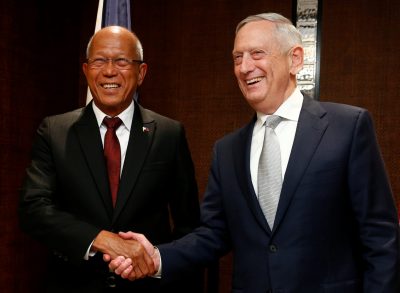At the start of 2019, it looked like the US–Philippines alliance was heading for crisis. Delfin Lorenzana, the normally pro-American Philippine Secretary of National Defense, began calling for a review of the 1951 Mutual Defense Treaty (MDT) and its application in the disputed waters of the South China Sea. The danger hasn’t completely passed, but it increasingly looks as if the alliance will come out even stronger than before.

By the end of 2018, on-the-ground security cooperation — including joint exercises, arms transfers and training — was operating at pre-Duterte levels. But deeper questions of US credibility in the face of an increasingly omnipresent Chinese threat in the South China Sea remained unanswered. Concerns date back to former president Barack Obama’s 2014 claim that the US commitment to defending the Philippines was ‘ironclad’ — an artful but ultimately meaningless dodge meant to avoid a firm answer on whether the treaty covers the South China Sea.
At stake for the Philippines is an unpleasant but increasingly clear set of facts. If the Philippines hopes to stand up to China in contested waters in the long term, it will eventually risk a violent response. When that happens, its only credible deterrent will be the threat of US intervention through the MDT. But if that is an empty threat, Manila needs to know and plan accordingly. This is what led Lorenzana in December to begin threatening to demand clarity from the United States, even if it meant a rupture in the alliance.
To its credit, the US State Department moved quickly once it realised the danger was real. In February, Secretary of State Mike Pompeo flew to Manila where he sought to reassure Philippine President Duterte of the United States’ commitment to the Philippines.
He then held a joint press conference with the Philippine Secretary of Foreign Affairs Teodoro Locsin and said‘any armed attack on Philippine forces, aircraft or public vessels in the South China Sea will trigger mutual defence obligations’. That language was taken directly from Article 5 of the MDT and intended to make clear that, while the United States won’t take sides on who owns which island, it would respond to any attacks against Philippine assets no matter where they occur.
But Lorenzana continues to call for a review. He has said he doesn’t worry about the text of the MDT. What he wants are specific responses to specific contingencies below the threshold of military force. Such threats have been on clear display since December 2018 when China deployed hundreds of militia vessels around the Philippine-held Thitu Island.
It looks increasingly like the United States and the Philippines (at least when it comes to the defence establishment) are getting on the same page about Chinese paramilitary coercion. In June, US Ambassador to Manila Sung Kim told the Philippine press that he thought an attack by Chinese maritime militias would be included in Pompeo’s MDT clarification.
But the United States remains concerned about another issue: slow progress in the Enhanced Defense Cooperation Agreement (EDCA). The agreement was signed in 2014 to allow the United States to build facilities, preposition equipment and rotate forces through an initial set of five Philippine military bases. Without it, the closest US ground-based air power is 1300 nautical miles from the Spratly Islands. In January, the first EDCA facility was finally completed: a disaster-relief supply warehouse at Basa Air Base.
But there are signs that EDCA is starting to move. In February, US and Philippine fighter jets held a bilateral exercise at Basa in what could be the first in an irregular pattern of US deployments. And the US Defense Department’s Indo-Pacific Strategy Report, released in June, notes that 12 EDCA projects have been approved for 2019 and 2020 to ‘provide force posture enhancements, improve our future readiness, and improve the operational flexibility of the alliance during contingencies’.
Meanwhile, the next annual Bilateral Strategic Dialogue between US and Philippine officials will likely take place in July in Manila. The meeting will provide an opportunity for the two sides to launch the kind of review process that Lorenzana wants to see.
It is past time that the two countries jointly establish new guidelines for cooperation and launch a more robust alliance coordination mechanism, just as the United States and Japan did in 2015. These would create the platforms for more flexible, effective responses to contingencies in the South China Sea. The two sides should also consider upgrading the Bilateral Strategic Dialogue to a regular 2+2 meeting between their secretaries of state/foreign affairs and defence.
Together with the implementation of EDCA and more frequent US rotations, these efforts could lead to a much closer, more effective US–Philippines alliance. The alternative is inertia that will eventually lead right back to crisis.
[Gregory B Poling is Director of the Asia Maritime Transparency Initiative and a Fellow with the Southeast Asia Program at the Center for Strategic and International Studies (CSIS), Washington DC.]

No comments:
Post a Comment
Note: Only a member of this blog may post a comment.